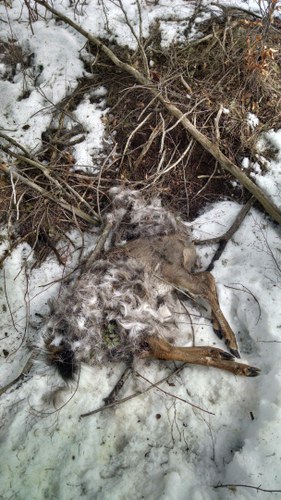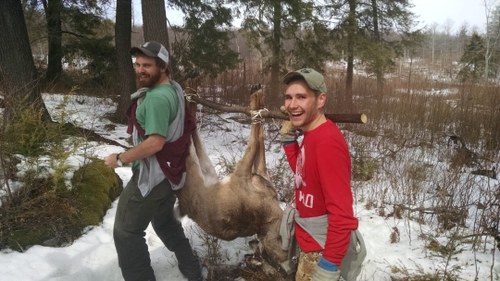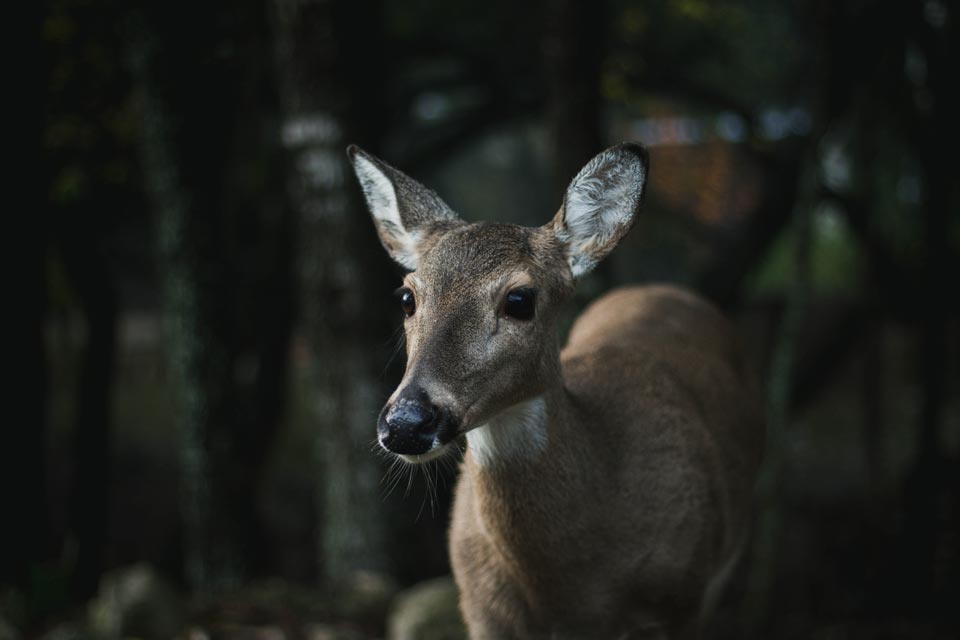We get excited because we are curious about the condition of the deer’s carcass. How did the deer meet its demise? Will we find bobcat, coyote, or maybe even fisher tracks at the site? Will there be a blood trail?
And we feel trepidation because hauling a 100-lb (or more!) dead deer over half a mile (or more!) of knee-deep snow without snowshoes is no easy task, especially when the area has steep topography.
Well, we received such a call last Sunday evening, so after checking traps on Monday, we grabbed rope and our radio-tracking equipment and headed off towards the location of the last GPS point provided by the deer’s radio-collar.
Our GPS informed us that the carcass was half a mile from the road. Ugh! But the snow had frozen overnight and supported our weight as we walked, for which we were grateful. And most of the walk was down a log-skidder road, for which we were also grateful.
Of course, these conditions did not last forever. Eventually our feet started to sink into the snow and we found ourselves fighting our way through painful brambles.
We soon arrived at the GPS location, which proved to be correct (in the past we were informed of a false mortality signal and wound up chasing after a deer that was very much alive and fleeing from us – making us walk circles in deep snow for hours).
We found the doe’s carcass beneath a small patch of hemlocks. A bobcat—identified by its tracks—cached the deer beneath the deer’s own hair, which the bobcat pulled out and laid over the deer. The head was partially hidden beneath a few large sticks.

Needless to say, we were simultaneously amused by and in awe of the bobcat’s efforts.
After snapping a few photos, we tied the deer to a large stick, pig-roast style, then Richard and Matt threw each end of the stick over their shoulders. So began our first attempt to extract the deer from the forest.
It did not go well.
Walking at the same pace as someone else through snow that is melting and thus is no longer supporting the weight, while carrying a heavy object, is no easy task. (At least…I imagine it is. I never had to give it a try. Hah!)
We quickly abandoned our first plan and resorted to taking turns dragging the carcass through the snow. Of course, this meant we were faced with many obstacles—brambles, felled trees, rocks and boulders, etc. We began to regret our decision to not bring the sled, which we carried on past excursions and never used (minus for sledding, obviously) due to how cumbersome it was. This time, a sled definitely would have come in handy.
When we finally made it back to the log-skidder road, we took turns shouldering the carcass itself and walking a few hundred yards. This was an exhausting but somewhat satisfying task. (At last I can stop wondering whether I am capable of such a thing—the uncertainty used to keep me up at night…)
After hours of walking, sweating, fighting our way through brambles, and cursing every time we got cut or scraped or lost our balance or toppled over from the weight of the deer or just wanted to give up (you get the picture, we cursed a lot), we made it back to the trucks. The entire journey took three hours—the return trip alone took two.
We celebrated the sight of the trucks, put the carcass in the truck bed, practically inhaled water from our bottles, and climbed into the trucks to begin our second long journey of the day.
It was a 5-hour round trip to the Animal Diagnostic Lab at Penn State University to deliver the carcass for necropsy—all the while cursing ourselves for not to bringing a sled.
-Kelsey Wellington, Field Tech
Northern Field Crew
Follow-up: The necropsy report confirmed cause of death was predation by bobcat. As is typical for a bobcat kill, the neck had bite wounds and tissue trauma indicating the bobcat grabbed the neck while the deer was alive. In addition, there was foam in the trachea consistent with suffocation.
In our experience, bobcat kills are a fairly rare mortality type and even rarer for an adult deer. Of the 218 fawns we monitored in Pennsylvania’s original fawn study 49 died from predation, but only 3 of those were from bobcat predation. Of the 4,859 deer (>8 months old) we have captured in the past thirteen years this is only the 4th deer documented as a bobcat predation (of a total of 10 predator mortalities!).
If you would like to receive email alerts of new blog posts, subscribe here.
And Follow us on Twitter @WTDresearch
